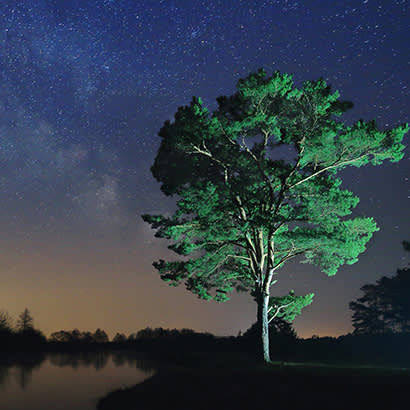
For an enhanced digital experience, read this story in the ezine.
Editor’s note: This column includes updated information.
Measuring and Treasuring Our Night Skies
The United States National Park Service’s (NPS) Natural Sounds and Night Skies Division (NSNSD) is located within the Natural Resources Stewardship and Science Directorate. The NPS Organic Act, Management Policies and Director’s Orders provide NSNSD with a mandate to protect the sensory resources of natural sounds and night skies. NSNSD measures and assesses the acoustic and nocturnal environments with new and innovative techniques that are based on peer reviewed scientific research and provides highly specialized technical assistance and guidance to 421 park units within the national park system. The division also assists partners in their efforts to keep the soundscape and night sky undisturbed by human noise and artificial light.
Protecting the night sky resource is an important part of the NPS mission to “preserve unimpaired the natural and cultural resources and values of the National Park System for the enjoyment, education and inspiration of this and future generations.” The NPS has been collecting and analyzing data used to understand night sky quality for 20 years. Data is collected with a state-of-the-art, charge-coupleddevice camera, which provides a snapshot of the entire sky, aiding in the measurement of artificial light that degrades the night sky. Capturing the essence of a lightscape with numerical data is complex, but advances in technology have made it possible to accurately measure light pollution.
When analyzing the hundreds of images collected at NPS units, one thing NSNSD expected to find was a greater amount of light pollution coming from outside park boundaries. A surprising finding was that many parks had lighting that was not night-sky friendly and was, in fact, a significant contributor to park light pollution.
In an effort to improve lighting and educate park staff, the NPS came out with the resource Best Practices – Night Skies. To assure that night sky-friendly lighting was used in NPS units, NSNSD needed to know where the “bad” lighting lived. To better understand lighting in NPS units, parks began performing lighting inventories, which are a way to collect lighting information, such as function, shielding, color temperature to quickly determine if that light needs to remain, be removed or replaced.
Through the lighting inventory process, parks can ensure that they are using best management practices by only using lighting when and where it is appropriate, and by replacing lighting that disrupts the nocturnal environment for visitors and wildlife. The NPS, in coordination with many partners, has developed a tool using the ArcGIS suite of products to organize lighting information.
Completing a lighting inventory also is a mandatory step for certification as an International Dark Sky Park. Currently, there are 36 NPS units certified by the International Dark-Sky Association (IDA). This certification gives parks that work to interpret, protect and share their night sky the recognition they deserve. All IDA-certified park applications can be found on the NSNSD website, including information about sky quality and night-sky friendly lighting. A lighting inventory webinar discussing the NPS methodology for lighting inventories can be found by clicking here.
Parks and park partners are encouraged to reach out to the Colorado Plateau Dark Sky Cooperative or the NPS NSNSD to develop a timeline to acquire the tools and personnel needed to complete a lighting inventory and subsequent lighting management plans.
Since 2001, the NPS has collected data in more than 100 national parks (for more information on these data collection methods, check out: NPS Methods – Night Skies). Many of the methods and resources used by NSNSD are available to the public via NSNSD websites, publications and by contacting the division directly. You can learn more about the NPS night skies work here or by visiting the Night Skies of the U.S. National Park Service Story Map. We are all under one big night sky and are happy to collaborate to protect our shared night.
Editor’s Note: The above originally appeared as a post on the Colorado Plateau Dark Sky Cooperative blog.
Sharolyn Anderson, Ph.D., is a Physical Scientist at National Park Service Natural Sounds and Night Skies Division. Ashley Pipkin is a Biologist at National Park Service Natural Sounds and Night Skies Division.

